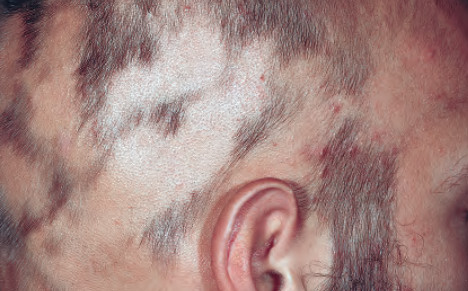
Tips
- Educate the patient about the chronic relapsing nature of alopecia areata.
- Reassure patients that the condition is benign and does not threaten their general health.
- The condition is highly unpredictable in presentation, evolution, and response to treatment.
- Consider full blood count, thyroid function tests, serum B12 and autoantibodies as a screen for associated autoimmune conditions.
- No treatment remains a therapeutic option especially in young children as spontaneous hair regrowth occurs in up to 80% of patients with limited patchy hair loss and in less than one year duration.
- Psychological assessment and management should be considered.
Medical treatment options for alopecia areata
Limited patchy alopecia
- Topical corticosteroids
- Fluocinolone acetonide cream 0.2% twice per day.
- Betamethasone dipropionate cream 0.05% once daily.
- Clobetasol (lotion, foam or shampoo ) may be under occlusion .
- For beard and eyebrow alopecia areta, long term use of high-potency topical corticosteroids is not advisable because of the potential for corticosteroid-induced skin atrophy.
- Intralesional steroids : Triamcinolone acetonide2.5–10 mg/mL or hydrocortisone acetate 25 mg/mL
- Application of topical anesthetic cream for 2 hrs under occulsion with a plastic wrab to be removed just before the injection
- One session every 3-4 wks.
- For scalp, 5 mg/mL (maximum volume of 3 mL per session) is the preferred concentration.
- For the eyebrows and face, 2.5 mg/mL can be used.
- Less than 0.1 mL is injected per site , about 1 cm between injection sites, not to inject more than 20 mg in total at one visit.
- After 6 months, discontinue injection If there is no response.
- Intralesional steroid will not prevent the development of alopecia at other sites and is not suitable for patients with rapidly progressive alopecia or alopecia totalis/universalis
- Topical minoxidil (2% or 5%).
- Topical anthralin (0.5–1% )cream applied daily for 20 to 30 minutes to be increased by 10 minutes every 2 wks up to one hour followed by washing the affected area with lukewarm water and shampoo.
- Topical Tofacitinib 2%.
Extensive and rapidly progressive alopecia areata
Topical
- Topical immunotherapy
- Contact immunotherapy by dinitrochlorobenzene (DNCB), squaric acid dibutylester (SADBE) and diphenylcyclopropenone (DPCP) starting at low concentrations (e.g. 0.001% DPCP) once per week.
- Continue for 6-12 months before evaluating efficacy.
- Topical corticosteroids
- Clobetasol propionate 2.5 g under occlusion 6 d/wk for 6 months.
- Topical anthralin: 0.5-1% cream applied for 20-30 minutes daily, gradually increasing contact time
Systemic
- Methylprednisolone: 500 mg/day for 3 days or 5 mg/kg twice a day over 3 days.
- Triamcinolone: 40 mg Im monthly.
- Prednisone: 40-60 mg per kg, Taper over 4-6 weeks.
- Dexamethasone: 5 mg/day, 2 days a week for at least 12 weeks.
- Prednisolone: 200 mg once a week for 3 months.(Ref)
- Methotrexate :0.2-0.4 mg/kg/ week.
- Cyclosporine: 2.5-6 mg/kg/d.
- Azathioprine: 2.5 mg/kg/day.(Ref)
- Oral Janus kinase (JAK) inhibitors
- Tofacitinib: 5 mg twice daily.
- Ruxolitinib: 10-20 mg twice daily.
- Baricitinib: 2- 4 mg daily.
- Sulfasalazine is started at an initial dose of 500 mg twice daily and then gradually increased to 1 g three times a day.
- Dupilumab: 300 mg once weekly.
- Zinc gluconate : 30-50 mg/day
Eye lid AA
- Latanoprost 0.005% to the eyelid margins every night.
- Bimatoprost 0.03% eye drops once a day on to the eyelid margins for 1 year.
Physical treatment options for alopecia areata
- PUVA ( 20-40 treatments ).
- Excimer laser: twice weekly.
- Platelet-rich plasma
Cosmetic treatment
- Wearing a wig.
References
- The efficacy and safety of JAK inhibitors for alopecia areata: A systematic review and meta-analysis of prospective studies[link].
- An Updated Review on Current Treatment of Alopecia Areata and Newer Therapeutic Options.[link]
#Alopecia Areata #Alopecia Areata treatment